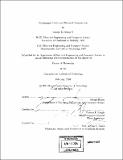Performance limits on chemical computation
Author(s)
Homsy, George E. (George Edward), 1965-
DownloadFull printable version (5.948Mb)
Other Contributors
Massachusetts Institute of Technology. Dept. of Electrical Engineering and Computer Science.
Advisor
Thomas F. Knight.
Terms of use
Metadata
Show full item recordAbstract
A class of novel computers uses solute concentrations of distinct chemical species as logic signals and diffusion for signal transport. I establish a bound on the speed, density, and error rate of such computers from first principles. I let the chemical computer engineer choose a "design tuple" of independent parameters: number of chemical species, total solute concentration, signal molecule size, and a parameter called the "cell size". I establish a functional relation between the design tuple, and the "performance tuple": (operating frequency, signal density, error rate). I give a lower bound on the probability of a logic error in one computation step, and an upper bound on the frequency of operation, both as functions of the design tuple. I evaluate these bounds for ssDNA oligomers, and conclude that DNA computation has unacceptable error rates if the hybridization regions are less than eight nucleotides in length. I then argue that, given a suitable scalar-valued performance metric as a function over performance tuples, there is a globally optimal design tuple maximizing performance. I present two conjectures seeking to explain (a) why neurons use small molecules to transport information, and (b) why cells have the size they do. In part two I develop such a performance metric based on Toffoli's computation capacity and computation density, extending and generalizing in these ways: * as a local statistic on a uniform system, it can be evaluated for very large systems without exhaustive counting (cont.) * it explicitly takes the error rate of the underlying physical process into account I then show a relation between this metric, and a quantity of dynamic systems called specific ergodicity. This is a novel result of theoretical importance, and is the central result of part two. It allows me to unambiguously compare the utility of computers varying vastly in speed, error rate, and signal density. I compare the maximum possible performance of proposed DNA computers from the literature with current commodity electronic computers, and conclude that diffusion-driven, DNA hybridizaton based computers cannot exceed the performance of current electronic computers by more than a factor of 40000, and probably by much less.
Description
Thesis (Ph. D.)--Massachusetts Institute of Technology, Dept. of Electrical Engineering and Computer Science, 2004. Includes bibliographical references (p. 167-174).
Date issued
2004Department
Massachusetts Institute of Technology. Department of Electrical Engineering and Computer SciencePublisher
Massachusetts Institute of Technology
Keywords
Electrical Engineering and Computer Science.